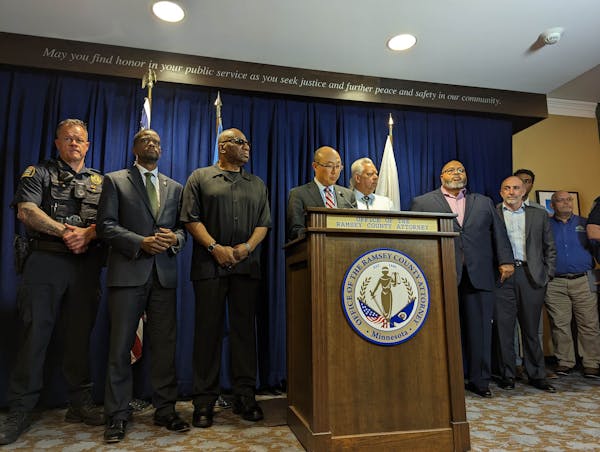Every year Bobby Nabors and Venita Bengazi decorate their home to brighten their stretch of Rice Street in St. Paul's North End. They spend hours preparing for each holiday, lining pumpkins on their porch steps or stringing Christmas lights around a tree in their yard. They are among the few people on the block who decorate, but both say it's worth it to see the reactions of their neighbors and 4-year-old granddaughter.
But for the first time in their five years there, only a handful of kids chimed "trick or treat" at their doorstep. It's one reason Nabors and Bengazi say they're not yet noticing last year's drop in violent crime.
"You're not going to have anybody come if they're talking about crime all the time," Nabors said. "You've got to clean house before you start talking about inviting somebody in."
Despite rising concerns across the Twin Cities, violent crime in Minnesota's capital city ebbed in 2023. A Star Tribune analysis of St. Paul police data shows crime in most major categories declined in 2023, reversing a pandemic-era surge of violence in many American cities after the murder of George Floyd in Minneapolis. That surge contributed to a record rate of homicides in recent years which has scarred residents and forced authorities to figure out how they can prevent future crimes.
Ebbs and flows
A Star Tribune analysis of decades of homicides in St. Paul shows that a crime surge that started before the pandemic has begun to slow. Robberies are down 8%, aggravated assaults are down 14% and rapes down 15%. And last year's surge of auto thefts driven by stolen Kia and Hyundai vehicles has decreased by a third.
Federal data show there have been more than 900 homicides in St. Paul since 1976, an average of around 20 deaths a year. Homicides between 2019 and 2022 surpassed that average, but last year's tally of 32 murders by late December is an improvement after 2022's grim record of 40.
Many of those deaths involved gun violence, but police say that crime prevention efforts are working.
St. Paul Police Department Deputy Chief Paul Ford of the major crimes division said all firearms incidents are down 25% from last year, "but at the same time, while we're seeing these reductions in gun crimes, we're recovering more guns."
Ford added that fewer shots are being fired as well — the average number of bullet casings recovered from crime scenes decreased from eight to six. "So we're having an impact in a whole bunch of ways, and I think one of the biggest pieces is the intervention and the prevention part."
Despite city leaders' efforts to prevent crime, new obstacles have slowed their progress. Deadly firearms are now more accessible, and arguments on social media often spill into real life. Accusations on social media preceded a 2021 shooting at a St. Paul funeral that killed one and injured three others, and in August, a social media dispute between rival gangs led a man to fatally shoot 20-year-old Marcus Anthony Baker Jr. on Raspberry Island. Court documents say Baker wasn't affiliated with gangs.
"Different groups who were more established gangs with hierarchies and leadership, and they had territories and they had certain criminal enterprises they were involved in — that's not really how it works anymore," Ford said. "It's driven by social media and respecting, and a lot of that other stuff doesn't really exist — at least in our area."
Residents like Nabors and Bengazi may know that better than most.
Since 2016, around two dozen people have been killed within a mile of the couple's Rice Street home. They believe much of the violence stems from young people without resources, turning neighborhoods into danger zones where innocent people can get caught in the crossfire.
'Always trouble there'
Family members warned Monica Holley to avoid 1200 Hazelwood St.
"There's always trouble there," Gail Wright remembers telling her granddaughter. On the night of Oct. 5, Holley and three others were struck by gunfire there. Investigators collected dozens of bullet casings at the scene, and the three others with bullet wounds were treated at Regions Hospital. Holley died of her injuries. She was 14. Police are still searching for the culprit.
Wright says the family has struggled to cope with the shooting and the void Holley's death left in their lives. They now worry that violence can strike from anywhere.
"It's a basic concern [that] anything could happen wherever you go. You're always trying to keep your head on a swivel to make sure you know your surroundings and where you're going," Wright said. "It just doesn't feel [as] safe as it used to be."
Violent crime across the country tends to spike at certain times of the year, but Ford believes such crimes are also driven by a lack of resources — like stable work or transportation — which tempts people to commit crime in order to survive. The department's ASPIRE Unit (A St. Paul Intervention and Recovery Effort), launched in 2022, aims to address that. The unit pairs officers with social workers and other community leaders to connect people who are at-risk with resources they need to turn away from crime.
The work has earned support from leaders like Police Chief Axel Henry, who touted the team's impact on gun violence during an April City Council presentation. Other such police efforts include an internship program to teach Central High School students trade skills and a summer soccer clinic for vulnerable youth from southeast Asia, but Ford says they need consistent effort in order to make a difference.
St. Paul Mayor Melvin Carter has supported a bevy of similar initiatives during his tenure, launching the Office of Neighborhood Safety months before funneling $4 million in federal pandemic aid grants to local organizations working to prevent violence. The mayor also announced plans to spend about half of $13.6 million in public safety aid from the state on gun violence intervention initiatives for the next three years.
Some of those initiatives are driven by Brooke Blakey, director for the Office of Neighborhood Safety. Blakey coordinates work between the ONS, SPPD and other community organizations to provide resources to victims of violence in the hopes of preventing crime. She said Carter's proposed budget could strengthen the work of her office, adding more staffers and wrap-around services for violence victims. Blakey said data shows people are less likely to resort to violence if needs like housing and transportation are met. The City Council approved the budget with minor revisions this December.
Regardless, Blakey says her team has more work ahead.
"Probably the biggest obstacle that ONS will face is that individuals will say, 'It's not working.' There will be a homicide or there will be another shooting and they'll say, 'See? We gave them this money and it didn't work,'" Blakey said. "To bring down our homicide rate, it's all in. It's not only the police department and ONS. It's our Parks and Rec, it's our department of safety and inspections, public works — it's that whole enterprise approach of looking at what is best for our city."
For Gail Wright, the keys to deterring violence are fewer semiautomatic weapons and more community policing. Wright believes there's no reason for regular citizens to have such guns, and she said police foot patrols in hot spots could make a difference.
Nabors and Bengazi say investing in the community pays dividends in reducing crime. To them that means improving access to extracurricular activities for youth. The couple also suggested that police officers interact with residents in non-confrontational settings to get to know them.
"We live in a society that gets colder with these things, but as an individual we search our own hearts to figure out what we've got to do," Nabors said. "If this is your city, then you should be wanting to do everything to keep it right. … Each one of us can do our part."

DFL Sen. Nicole Mitchell returns to Capitol after burglary charge, casts votes amid criticism
Police now say all 5 women have so far survived rollover of SUV exiting I-94 in Minneapolis

Brooks: Kristi Noem's tale of killing her dog backfires

Defense attorneys in first Feeding Our Future trial say defendants served 'real food'

